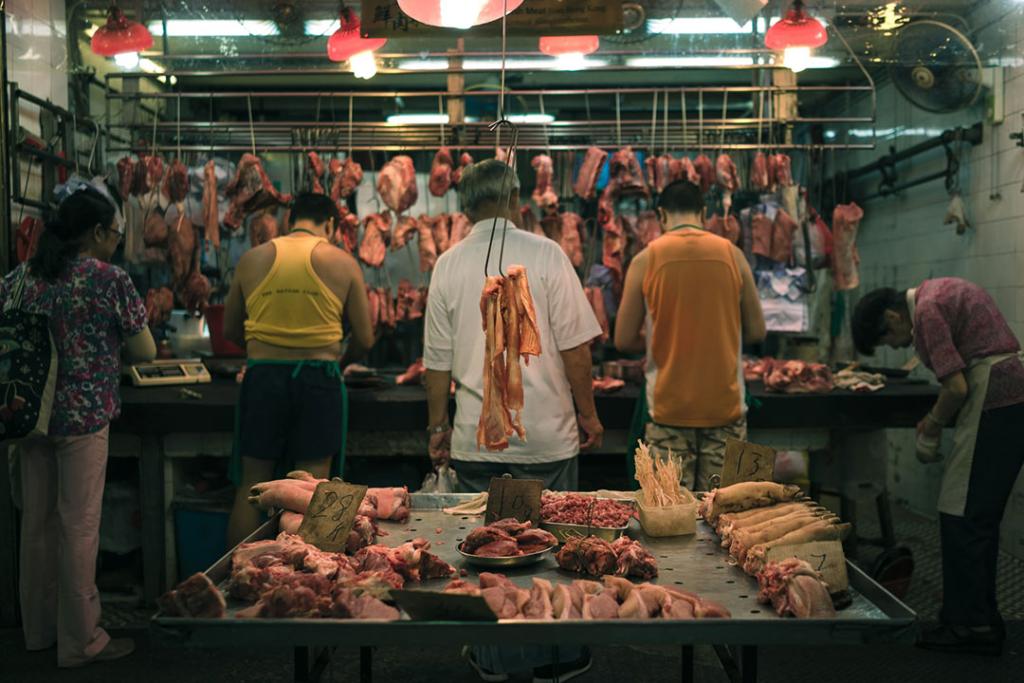COVID-19 and the wildlife trade

Photo: Ship Kei Market Butcher Shop by Natalie Ng on Unsplash. Meat is a staple item found at most markets around the world. The majority of animals sold for meat have been domesticated and are raised on farms where disease can be closely monitored and treatments can be issued. When many species of wildlife are in close proximity to one another, live or dead, the likelihood of disease transmission increases.
Zoonotic diseases
On New Year's Day 2020, China declared a problem - the novel coronavirus COVID-19.
COVID-19 is an infectious air-borne virus causing a cough, fever and in some cases, more severe respiratory problems and pneumonia. Although it is difficult to trace the exact origin, COVID-19 is thought to have originated from a seafood market in Wuhan, China which was selling wildlife for human consumption.
Diseases that spread from animals to humans, such as SARS, MERS, Avian and Swine flu are called zoonotic diseases. Research currently suggests that COVID-19 originated from horseshoe bats. COVID-19 has jumped species and pangolins are believed to be the cause of animal to human transmission, however more scientific study is still required.
Wet markets
Pangolins are consumed at wet markets around the world and were for sale in Wuhan market. Pangolins are one of the most endangered and trafficked mammals in the world. Their scales are used in traditional Chinese medicine and their meat is eaten in Asia as a luxury food item. Estimates suggests some species will go extinct within the next ten years.
At Wuhan market, a diverse range of both legally and illegally traded species were available for sale. Wet markets keep live wild and farmed animals on site and slaughter them upon purchase. Each species acts as a potential carrier of a broad array of bacteria and viruses. These animals are often kept in very poor, cramped conditions in stacked, dirty cages. People working at the market then handle these potentially sick animals and sell them to customers for consumption. These conditions are perfect for spreading disease.
Wildlife farming
Wet markets are found all over the world. In China, many wet markets are approved by the state and are an essential source of food and work. In the 1970s China was much poorer than it is today. Many citizens were starving as the State-controlled farming system could not keep up with feeding a population of 900 million people. In 1978, the government gave up control of farming and allowed major agricultural companies to take over. The smaller individual farmers began capturing and raising wildlife on their farms in order to sustain themselves. Bats, turtles and snakes were commonly farmed and as peasant farmers were helping to feed the people, they were supported by government.
In 1988, the government actively encouraged the domestication of wild animals and these small sites grew into industrial scale farms. Largely unregulated in terms of welfare and size, these farms became the perfect setting for animal to human disease transmission.
Illegal wildlife trade
Wet markets continued to expand and grow in popularity. In some cases, wet markets also became a cover for illegal wildlife trade in species such as tigers and pangolins. The wildlife industry in China is economically strong and has been accused of pushing false health claims to drive demand. The vast majority of Chinese people do not buy or eat from wet markets. It is thought to be a small minority of wealthy people who buy wildlife for health claims and use such purchases to boost their social status.
The future of wildlife farming
In light of the recent spread of COVID-19 the Chinese government has stated it is reviewing its 1988 law which promotes industrial scale wildlife farming. Whilst people and wildlife remain in such close contact it is likely novel diseases, such as SARS and COVID-19, will continue to emerge. Internationally, many people are highly dependent on the sale of animals for an income and a food source. A careful balance must be struck to ensure the safety of everyone.
Sources and further reading
- National Review: The Chinese wild-animal industry and wet markets must go 19 March, 2020
- A pneumonia outbreak associated with a new coronavirus of probable bat origin (pdf) - Nature, Vol 579, 12 March 2020
- Coronavirus piles pressure on China's exotic animal trade (pdf) - Financial Times, 23 February 2020
- IFAW: Will we learn our lesson from the coronavirus epidemic? - 3 February 2020
- China Culture: Law of PR China on the protection of wildlife
- Wildlife legislation and the empowerment of the poor in Asia and Oceania (pdf) - FAO legal papers 2010
